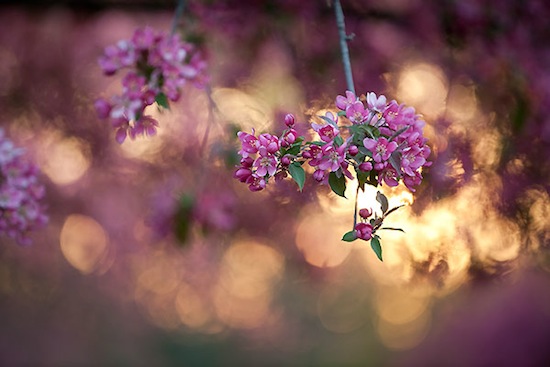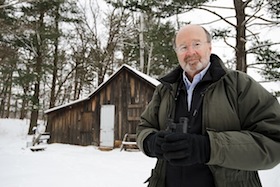In the eastern U.S., spring flowers keep pace with warming climate

The sun sets behind a bouquet of blooms on a crabapple tree at the University of Wisconsin Arboretum in spring, 2010. In a new study, scientists have demonstrated that native plants in the eastern United States are flowering as much as a month earlier in response to a warming climate.
Photo: Jeff Miller
Using the meticulous phenological records of two iconic American naturalists, Henry David Thoreau and Aldo Leopold, scientists have demonstrated that native plants in the eastern United States are flowering as much as a month earlier in response to a warming climate.
The new study is important because it gives scientists a peek inside the black box of ecological change. The work may also help predict effects on important agricultural crops, which depend on flowering to produce fruit.
The study was published online today (Jan. 16, 2013) in the Public Library of Science One (PLoS One) by a team of researchers from Boston and Harvard Universities and the University of Wisconsin–Madison.
Compared to the timing of spring flowering in Thoreau’s day, native plants such as serviceberry and nodding trillium are blooming 11 days earlier, on average, in the area around Concord, Mass., where Thoreau famously lived and worked. Nearly a thousand miles away in Wisconsin, where Leopold gathered his records of blooming plants like wild geranium and marsh marigold, the change is even more striking. In 2012, the warmest spring on record for Wisconsin, plants bloomed on average nearly a month earlier than they did just 67 years earlier when Leopold made his last entry.
“These historical records provide a snapshot in time and a baseline of sorts against which we can compare more recent records from the period in which climate change has accelerated,” explains Stan Temple, a co-author of the study and an emeritus UW–Madison professor of wildlife ecology. Temple is also a senior fellow at the Aldo Leopold Foundation in Baraboo, Wis., a stone’s throw from the iconic shack where Leopold made many of his observations.
Although the new study is not the first to document the relationship between temperature and flowering dates and the trend toward climate-driven early blooming, it is the first to suggest that the trend in flowering plants may continue beyond what has been observed in controlled studies. The work thus has important implications for predicting plant responses to changing climate, essential for plants such as fruit trees, which are highly susceptible to the vagaries of climate and weather.
“We used relationships revealed in historical records to predict how 47 species of native plants would respond to unprecedented spring temperatures, but that has only been possible because naturalists, past and present, kept good records of what they observed in nature,” Temple avers.
Importantly, the results give scientists a peek into the subtleties of ecological change in response to climate change. Flowering of native plants, a harbinger of spring in the world’s temperate regions, signals the start of the growing season. Changes in the timing of flowering have broad implications for the animals and insects that depend on the plants.
“Earlier blooming exposes plants to a greater risk of experiencing cold snaps that can damage blossoms and prevent fruiting,” says Temple. “The Door County (Wisconsin) cherry crop was ruined in 2012 because the trees bloomed very early in response to record-breaking warmth only to be hit by subsequent frost.”
“The Door County cherry crop was ruined in 2012 because the trees bloomed very early in response to record-breaking warmth only to be hit by subsequent frost.”
Stan Temple
The new study keyed on the detailed phenological records of 32 native plant species in Concord, Mass., kept between 1852 and 1858 by Thoreau, a pioneering naturalist best known as the author of “Walden,” as well as later records. A second data set of flowering times for 23 species in southern Wisconsin was compiled by Leopold, a renowned wildlife ecologist at the University of Wisconsin and author of “A Sand County Almanac.” Leopold and his students gathered their data in Dane and Sauk Counties between 1935 and 1945. From 1977 until she died in 2011, Aldo Leopold’s daughter Nina Leopold Bradley resumed the collection of phenological records near the Leopold Shack.
“Both Thoreau and Leopold were part of the 19th century naturalist movement in which individuals often kept meticulous daily journals recording the things they observed in nature,” notes Temple. “Most of those journals have been lost over time, but Thoreau and Leopold were famous writers, and their journals have been preserved, providing us with unparalleled historical data.”
Comparing modern observations with those gathered by Leopold shows that in 1942, when the mean spring temperature in southern Wisconsin was 48 degrees Fahrenheit, black cherry bloomed on May 31. In 2012, with a mean spring temperature of 54 degrees Fahrenheit, black cherry blooms were observed as early as May 6. In 1942, Leopold’s notes show the woodland wildflower bloodroot blooming on April 12. In 2012, bloodroot was first observed blossoming March 17.
Together, these two data sets provide a unique record of flowering trends in the eastern United States over a 161-year period, says Temple.
“Leopold and Thoreau had no idea their observations would help us understand responses to human-caused climate change,” says Temple. “But Leopold knew his records might be useful in retrospect when he wrote: ‘Keeping records enhances the pleasure of the search, and the chance of finding order and meaning in these events.'”
Tags: climate change, ecology, research





